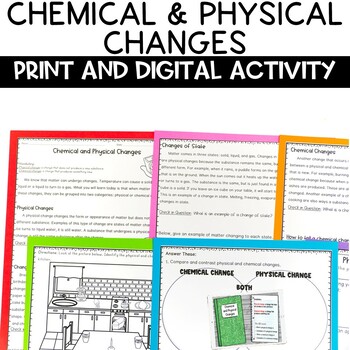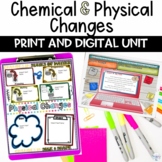Physical and Chemical Changes Activity
- PDF
- Google Apps™

What educators are saying
Also included in
- Teach a unit on chemical and physical changes using these print, digital, and hands-on lessons and activities. Students will learn about characteristics and examples of a physical and chemical change by reading the printable worksheets or digital Google Slide activity. Hands-on and digital activitiePrice $22.25Original Price $31.75Save $9.50
Description
Students will learn about chemical and physical changes using the teacher presentation, print, or digital lesson. Students will gain background information on the types of matter changes. Students will be able to identify specific real-world examples of physical and chemical changes, review definitions, and summarize and identify the characteristics of each. Guided reading questions allow students to analyze and demonstrate an understanding of chemical and physical changes.
Students will be able to:
- Explain what a physical change is
- Identify examples of a physical change
- Explain what a chemical change is
- Identify examples of a physical change
- Compare and contrast chemical and physical changes
This chemical and physical changes lesson includes:
- Sneak Peek into My Classroom: Teacher instructions to adapt this lesson to your unique classroom
- Teacher presentation - use this as an anchor to teach students and illicit classroom discussions about chemical and physical changes concepts.
- Student notes packet - This packet follows the teacher's presentation. Students will fill in the blanks on their note sheets as they learn about changes in matter. Students can also complete the comprehension questions and use the sheet to study for an upcoming assessment.
- Digital link to the Google Slide version
- 9 page printable packet
- Includes background information
- Comprehension activities
- This activity can be used as independent practice for students.
- 10 slide digital version
- Answer key
How to use this activity in your classroom:
- View the teacher presentation on the Smartboard. The teacher presentation will introduce physical and chemical changes to your students. As you go through the presentation, students should fill in their packets. Once completed, students will have a notes packet containing information about matter changes, ways to identify the changes, and different examples of chemical or physical changes.
- Assign the print or digital student activities as:
- Sub plans
- Homework assignments
- Enrichment activity
- Science station
- Review activity
This activity will help students prepare and gain background knowledge for meeting NGSS:
5-PS1-2: Matter and Interactions: Measure and graph quantities to provide evidence that regardless of the type of change that occurs when heating, cooling, or mixing, the total weight of matter is conserved.
5-PS1-4: Conduct an investigation to determine whether mixing two or more substances results in new substances.
MS-PS1-2: Analyze and interpret data on the properties of substances before and after the substances interact to determine if a chemical reaction has occurred.
Check out this feedback from teachers!
- Great resource! NF articles helped supplement the teaching of concepts.
- Another great product, Teaching Muse! Never disappointed!
- I did this as stations for my sped students, and they loved it! So great!!! Thanks :)
- Great resource. A variety of worksheets for students to practice or review content.
- Such a great resource! I love that it had a real-world application with the kitchen scene.
Other lessons and activities to support your unit on chemical and physical changes:
- Anchor Chart Posters
- Nonfiction Packet with Activities
- Nonfiction Packet with Activities Google Drive Version
- Lab Activities and Demonstrations
- Chemical Changes Egg Experiment
- Task Card Review Activity
- Flip Book Review
- Chemical and Physical Changes Crime Fighters
- Review Game
- Assessment
- Project
Kindly Note: If you have questions, do not hesitate to email me at Teaching Muse Email
PLEASE PREVIEW BEFORE PURCHASING
__________________________________________________________________
Thank you for visiting Teaching Muse. I would love for you to become a follower.
Teaching Muse followers receive new product information and discounts on any new items!
__________________________________________________________________
All rights reserved by Teaching Muse. This product is to be used by the original downloader ONLY. Copying for more than one teacher, classroom, department, school, or school system is prohibitAdditionally, this product may not be distributed or displayed digitally for public view. Failure to comply is a copyright infringement and a violation of the Digital Millennium Copyright Act (DMCA). Intended for classroom and personal use ONLY.






